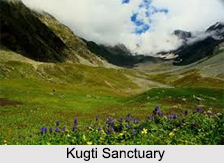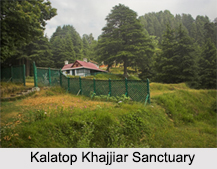 The state of Himachal Pradesh is located in the northern part of India. This state has convoluted topography of interlocking mountain chains, snowy peaks and plunging river valleys. Such a geographical terrain offers ample opportunity for trekking, rafting, paragliding and skiing. It is for this reason that adventurous tourists are drawn to this state. Wildlife Sanctuaries also form part of the places of attraction in Himachal Pradesh. Some of these sanctuaries are described below.
The state of Himachal Pradesh is located in the northern part of India. This state has convoluted topography of interlocking mountain chains, snowy peaks and plunging river valleys. Such a geographical terrain offers ample opportunity for trekking, rafting, paragliding and skiing. It is for this reason that adventurous tourists are drawn to this state. Wildlife Sanctuaries also form part of the places of attraction in Himachal Pradesh. Some of these sanctuaries are described below.
Renuka Sanctuary
Renuka Sanctuary is situated in Sirmour district. This sanctuary is spread over an area of about 4.028 square kilometers. There is also a buffer belt located outside the sanctuary, which covers an area of about 3 square kilometers. The entire sanctuary is Renuka Reserve Forest and has religious, aesthetic and cultural significance. Forest types of the sanctuary are dry mixed deciduous forest and dry sal forest. Leopard, spotted deer, jackal, hare, jungle cat, porcupine, etc are the fauna of Renuka Sanctuary.
Kugti Sanctuary
Kugti Sanctuary is located about 87 km from Chamb. It was established in the year 1962 and is spread over an area of about 378 square kilometers. This sanctuary serves as one of the few locations which provide protection to Himalayan tahr. Apart from Himalayan tahr, monal, snow cock, jungle babbler, red-billed babbler, great hill barbet, etc are also housed in this sanctuary.
Simbalbara Sanctuary
 Simbalbara Sanctuary is located in Sirmour district. This sanctuary is adorned by a perennial stream and dense sal forests with grassy glades. The sanctuary area provides protection to animals like goral, sambhar and chittal.
Simbalbara Sanctuary is located in Sirmour district. This sanctuary is adorned by a perennial stream and dense sal forests with grassy glades. The sanctuary area provides protection to animals like goral, sambhar and chittal.
Kalatop Khajjiar Sanctuary
Kalatop Khajjiar Sanctuary is situated at Kalatop and Khajjiar in Chamba district. It is spread over an area of about 30.69 square kilometers. This sanctuary is occupied by blue pine, deodar forest, bear, Himalayan black marten, leopard, deer, chesnut billed rock thrush, eurasian jay, whitewinged black bird, etc.
Daranghati Sanctuary
Daranghati Sanctuary is located in Shimla district. It was established in the year 1962 and is spread over an area of about 167 square kilometers. The occupants of this sanctuary are forests, pheasants like monal, tragopan, koklas and kalij and animals like musk deer and goral.
Churdhar Sanctuary
Churdhar Sanctuary is situated in Sirmour district. It is spread over an area of about 56.16 square kilometers. This sanctuary serves as a home to Himalayan black bear, barking deer, musk deer, etc.
Other Wildlife Sanctuaries of Himachal Pradesh
Majthal Sanctuary, Nargu Wildlife Sanctuary, Manali Wildlife Sanctuary and Chail Wildlife Sanctuary are some of the other Wildlife Sanctuaries of Himachal Pradesh.











